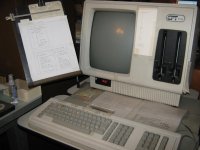Hello everyone,
I just found this great site..looks good and wow! there are some great collections on here! that's for sure. I myself have a very small collection, as I just started to get into collecting all types of vintage technology, not just computer systems. I love the early cpu's and systems, 70's and 80's, but I love em all really..
Just thought what you thought of this great system I have, it's from the CPT Corporation (now defunct), circa 1982. Originally these went for $13,000 (!!) for the system including cpu, keyboard, printer and boot, utility disks.
It's a "dedicated word processor", it does just that, no GUI or other programs exist for it. It still runs great and it can't be beat for producing great word processed documents.
Thought I'd mention it cuz I don't see CPTs mentioned much by folks. Besides the CPTs, I have some old Apples and an old Commodore. Non computer stuff that's old I have an old wall phone with brass bells, annunciators, camera with real bellows, and a few morse code telegraph keys. like I said, small collection, but you have to s tart somewhere.
Carlos
I just found this great site..looks good and wow! there are some great collections on here! that's for sure. I myself have a very small collection, as I just started to get into collecting all types of vintage technology, not just computer systems. I love the early cpu's and systems, 70's and 80's, but I love em all really..
Just thought what you thought of this great system I have, it's from the CPT Corporation (now defunct), circa 1982. Originally these went for $13,000 (!!) for the system including cpu, keyboard, printer and boot, utility disks.
It's a "dedicated word processor", it does just that, no GUI or other programs exist for it. It still runs great and it can't be beat for producing great word processed documents.
Thought I'd mention it cuz I don't see CPTs mentioned much by folks. Besides the CPTs, I have some old Apples and an old Commodore. Non computer stuff that's old I have an old wall phone with brass bells, annunciators, camera with real bellows, and a few morse code telegraph keys. like I said, small collection, but you have to s tart somewhere.
Carlos

